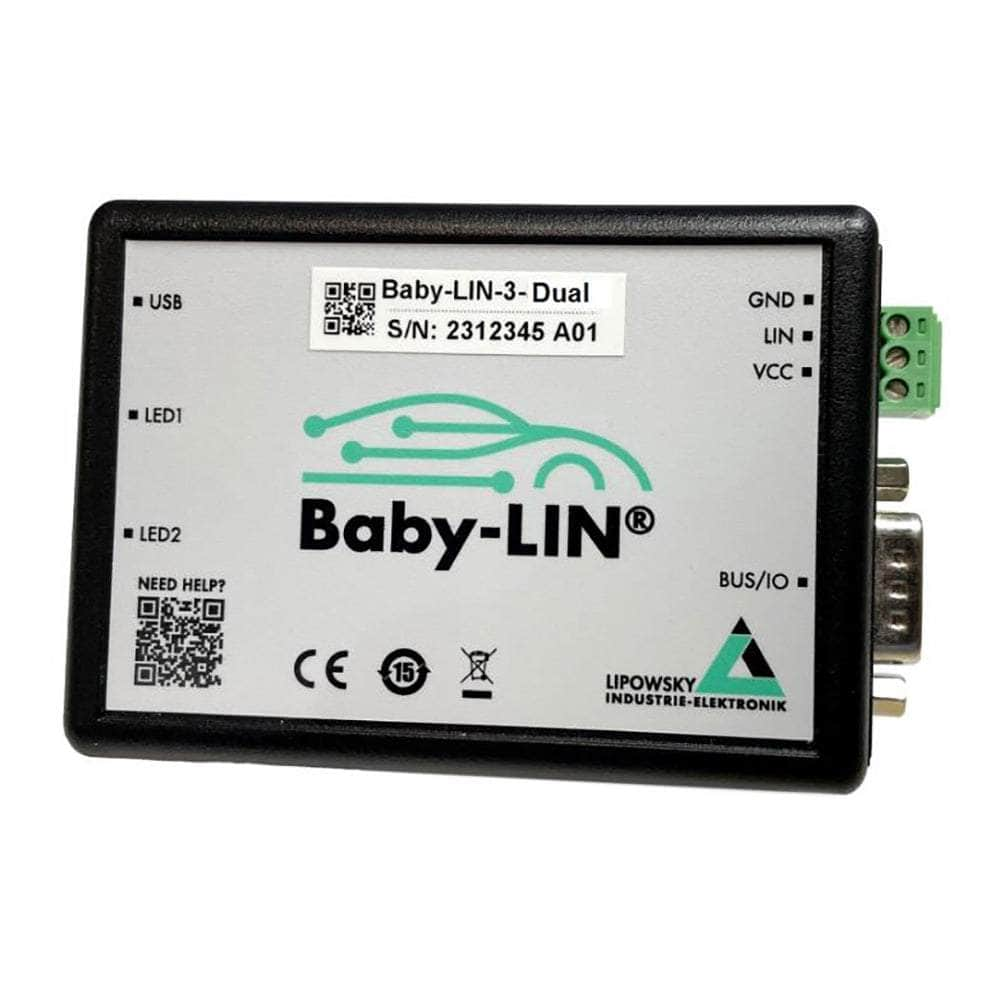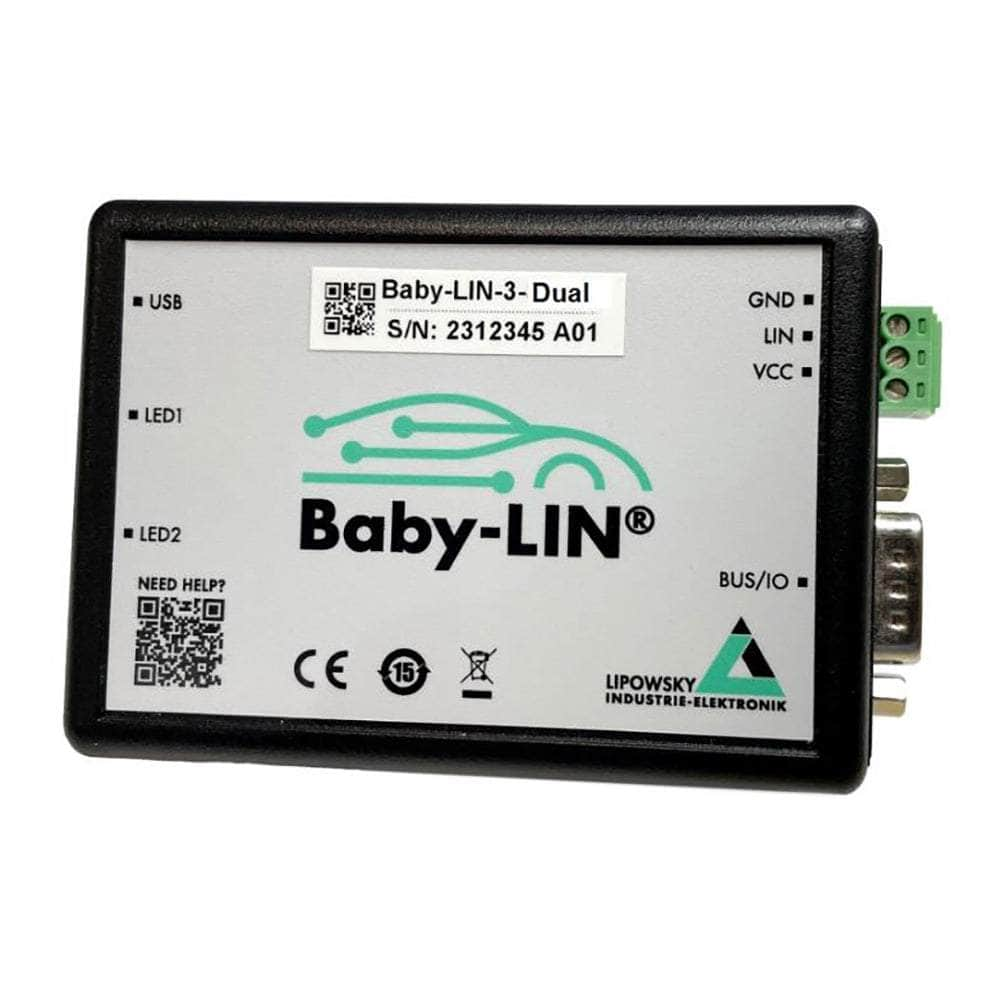
Key Features
Overview
Professional LIN and CAN Bus Testing Made Simple
The Lipowsky Baby-LIN-3-Dual represents the pinnacle of compact bus simulation technology, combining both LIN and CAN interfaces in a single, galvanically isolated device. Built around a powerful 480MHz ARM Cortex-M7 processor, this simulator delivers 60% faster performance than previous generations whilst maintaining the reliability engineers demand.
Featuring comprehensive support for LIN bus versions 1.2 through 2.2 and CAN High-Speed interface (ISO 11898-2) with optional CAN-FD upgrade, the Baby-LIN-3-Dual excels in both laboratory testing and production environments. The device supports bus voltages from 8-28V DC and can operate as master, slave, or in monitoring mode across both protocols simultaneously.
Versatile Testing Capabilities
Whether you're conducting residual bus simulations, end-of-line testing, or developing new ECU software, the Baby-LIN-3-Dual adapts to your workflow. The included LINWorks software suite provides comprehensive tools for LDF editing, session configuration, and real-time bus monitoring. Advanced users can leverage the Baby-LIN DLL with wrappers for C/C++, .NET languages, Python, LabVIEW, and VB6.
The device's standalone capability sets it apart from competitors, enabling autonomous operation without PC connection for endurance testing and production applications. With 32MB RAM and extended 500KB SDF memory, complex test scenarios execute reliably even in demanding industrial environments.
For enhanced connectivity, the Baby-LIN-3-Dual features a high-speed USB 2.0 interface with USB-C connector, ensuring fast data transmission and easy integration with modern test systems. Compatible with Windows 10/11 and various Linux distributions, it seamlessly fits into existing development workflows.
Downloads
Why Engineers Choose The Simulateur de bus Lipowsky Baby-LIN-3-Dual LIN
Accelerated Development Cycles
Production Line Integration
Comprehensive Protocol Support
Aperçu
Le Lipowsky Baby-LIN-3-Dual est un appareil de simulation de bus LIN et CAN polyvalent qui vous permet de contrôler, surveiller et tester facilement les communications LIN et CAN à partir d'un PC.
Caractéristiques principales
- Processeur Cortex M7 480 MHz pour des performances 60 % plus rapides que les modèles précédents
- Interface USB 2.0 haute vitesse 480 Mbit/s avec connecteur USB-C
- 32 Mo de RAM et mémoire SDF étendue de 500 Ko
- Prise en charge des tensions de bus LIN de 8 à 26 V CC à des vitesses allant jusqu'à 115 200 bauds
- Interfaces de communication isolées galvaniquement
- Gamme de modes de simulation de bus LIN et CAN
- Licence incluse pour la suite logicielle LINWorks de Lipowsky
Applications
Le Baby-LIN-3-Dual peut être utilisé dans diverses situations qui nécessitent une communication avec des appareils LIN ou CAN, notamment :
Recherche et développement
- Simuler les réseaux LIN et CAN pendant les phases de conception et de test
- Enregistrer les données du bus pour analyse sans PC connecté
Fabrication et contrôle de qualité
- Effectuer des tests de fin de ligne de production (EOL)
- Exécutez des tests de durabilité en exécutant des séquences de commandes préprogrammées
Service et réparation
- Diagnostiquez rapidement les problèmes en surveillant le trafic des bus en direct
- Identifier les calculateurs défectueux lors du dépannage
Prise en charge des bus LIN et CAN
Les pilotes de bus LIN et CAN intégrés offrent une prise en charge étendue des protocoles :
Bus LIN
- Versions LIN 1.2 et supérieures
- Refroidissement et normes SAE J2602
- Débits en bauds jusqu'à 115 200
- Fonctionnement 8-26 V CC
Bus CAN
- Interface conforme à la norme ISO 11898
- Prise en charge CAN 2.0 et CAN FD
- Débits de données CAN FD jusqu'à 8 Mbit/s
Capacités de simulation
Le Baby-LIN-3-Dual peut simuler une grande variété de configurations de nœuds :- Comportements de maître et d'esclave
- Réplication complète du trafic de bus
- Simulation de bus résiduel avec tous les nœuds sauf un
- Surveillance passive du bus sans nœuds
Les simulations LIN et CAN simultanées sont prises en charge.
Logiciel LINWorks inclus
Le Baby-LIN-3-Dual est livré avec la suite LINWorks de Lipowsky pour la gestion des projets de bus LIN et CAN. Caractéristiques de LINWorks :- Édition LDF
- Création de fichier SD
- Contrôle, surveillance et journalisation des bus
- Fichiers d'exemple et documentation
| General Information | |
|---|---|
Part Number (SKU) |
8001023
|
Manufacturer |
|
| Physical and Mechanical | |
Weight |
0.5 kg
|
| Other | |
Warranty |
|
HS Code Customs Tariff code
|
|
EAN |
5055383692231
|
Frequently Asked Questions
Have a Question?
-
What connectivity options are available?
The device features a high-speed USB 2.0 interface with USB-C connector for fast 480Mbit/s data transmission. LIN connections use 3-pin screw terminal connectors, while CAN interfaces utilise standard SUB-D9 connectors for industry-standard connectivity.
-
Is the device compatible with Linux operating systems?
Yes, the Baby-LIN-3-Dual supports Windows 10/11 (32/64-bit) and provides DLL interfaces for PC-based Linux (x86 & x64) and ARM-based Linux systems, ensuring broad compatibility across development platforms.
-
How does galvanic isolation benefit automotive testing?
Galvanic isolation prevents electrical interference between test equipment and target systems, eliminating ground loops and protecting valuable ECUs from potential damage. This ensures reliable data transmission and maintains signal integrity during critical testing procedures.
-
What voltage ranges does the device support?
The Baby-LIN-3-Dual supports bus voltages from 8-28V DC, accommodating both 12V passenger vehicle systems and 24V commercial vehicle applications. LIN bus specifically operates within 8-26V DC range with baud rates up to 115,200.
-
Can the device simulate both master and slave nodes simultaneously?
Yes, the Baby-LIN-3-Dual can simultaneously simulate LIN master/slave nodes and CAN nodes across both protocols. It supports residual bus simulation where all but one node is simulated, complete bus simulation, or passive monitoring configurations.
-
What makes the Baby-LIN-3-Dual superior to competitive solutions?
Unlike basic CAN interfaces or software-only solutions, the Baby-LIN-3-Dual combines hardware-accelerated protocol handling, galvanic isolation, dual-protocol support, and standalone operation. This integration provides reliability and performance advantages over separate tools or PC-dependent solutions.
-
Does the device support CAN-FD protocol?
The Baby-LIN-3-Dual includes CAN High-Speed interface (ISO 11898-2) as standard. CAN-FD functionality is available as an optional upgrade through a paid activation voucher, providing future-proof protocol support.
-
What software is included with the Baby-LIN-3-Dual?
The device includes a comprehensive LINWorks software suite featuring LDF editor, session configurator, bus monitoring tools, and sample files. The Baby-LIN DLL provides API access for custom applications in C/C++, .NET, Python, LabVIEW, and VB6.
-
Can the device operate without a PC connection?
Yes, the Baby-LIN-3-Dual features standalone operation capability. Once programmed with test sequences, it can execute autonomous testing routines without PC connectivity, making it ideal for production environments and endurance testing scenarios.
-
What LIN bus versions does the Baby-LIN-3-Dual support?
The Baby-LIN-3-Dual supports LIN bus versions 1.2, 1.3, 2.0, 2.1, and 2.2, providing comprehensive compatibility with modern automotive systems. It also supports Cooling and SAE J2602 standards for specialised applications.

